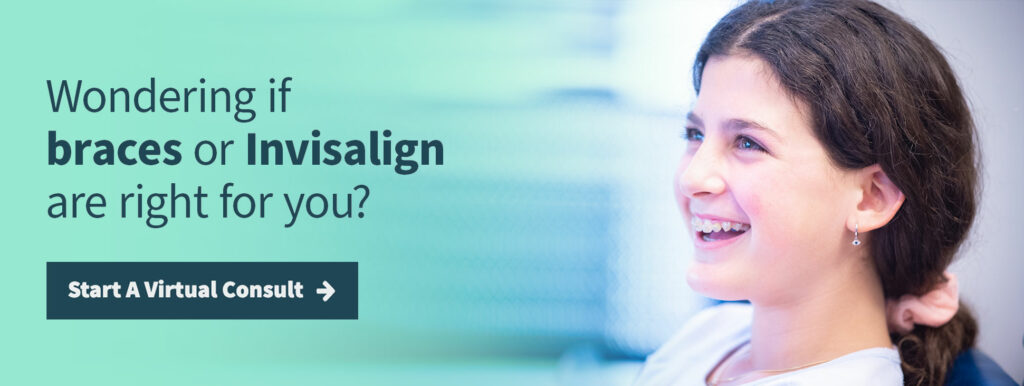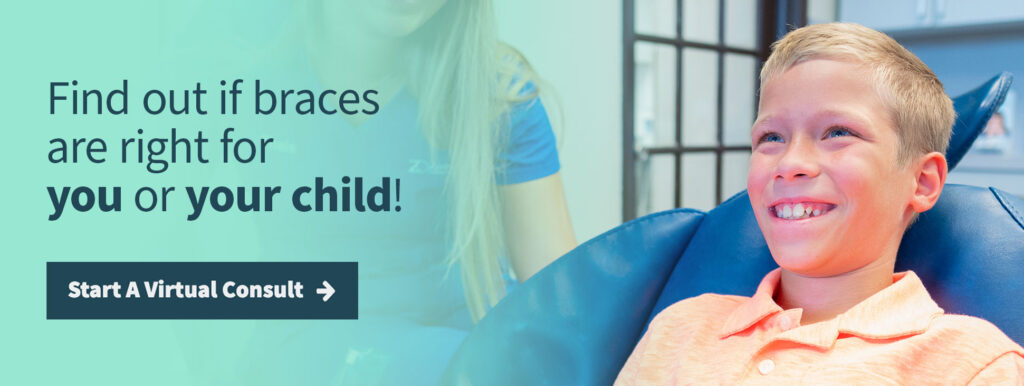Does your jaw pop when you chew? Does it get tired after eating? Do you have headaches or neck aches? It may be a disorder related to the joint between your jaws called the temporomandibular joint or TMJ.
TMJ Disorder can do more than cause pain. It can also cause excessive wear on your teeth, leading to cracks, breaks, and chips. It’s a painful condition that can get worse over time, but there are ways to help relieve your TMJ pain.
Zombek Orthodontics can help realign your jaws and bite with braces treatment, relieving pressure and pain on your joint. It can also help save your smile.
TMJ Disorder, often just called TMJ or TMD in short, relates to the misalignment and wearing down of the joint between your maxillary (upper jaw) and mandible (lower jaw). The joint’s primary purpose is to move up and down, but there is flexibility that allows it to move from side to side. This allows us to grind food between our molars (back teeth).
The ends of the mandible, called the mandibular heads, are meant to fit a certain way in the concave joints of the skull, called the mandibular fossa. The articular disk, a piece of tissue, is a cushion between the bones and keeps them from rubbing against each other.
If the jaws are not aligned properly, they can move around that disk and rub against each other. The friction between the bones can wear them down and cause pain in the surrounding ligaments and nerves.
What are some of the most common TMJ symptoms?
These symptoms may be subtle initially but worsen over time without treatment as the joint wears down. TMJ pain can make it difficult to bite and chew, leading to digestive problems. Misaligned jaws can also cause breathing problems, leading to sleep apnea and snoring. Both of these can affect your overall health.
If you are experiencing any of these symptoms, consult your dentist or orthodontist. The sooner these problems are diagnosed and treated, the less damage to your joints will occur.
How do you get TMJ pain in the first place? Some people are born with abnormalities of the jaw that can develop into TMJ pain. In other cases, TMJ can come from bad habits. Here are some of the ways you can get TMJ disorder:
Some causes are easier to treat than others, but there are ways to treat TMJ Disorder.

Can braces cause TMJ, or can braces help TMJ? Braces may cause temporary pain in your jaws as your teeth begin to move, but they won’t cause TMJ disorder. However, they can help, as can other methods of treatment.
Many people get TMJ from grinding their teeth. A mouthguard or nightguard may help stop the teeth grinding and reduce TMJ pain for those patients. You can have a mouthguard made professionally or purchase an over-the-counter guard called a “boil and bite” mouthguard.
With these mouthguards, you boil the plastic to soften it, then bite down and let it cool to custom-mold the mouthguard to your teeth.
Some people are able to relieve their TMJ pain through therapeutic jaw pain exercises. These exercises can include touching their tongue to the roof of their mouth and relaxing their jaw to let it rest.
Another exercise is to hold your fingers on each joint while slowly opening and closing your mouth. This helps build up your jaw muscles and reduce fatigue. By pressing your fingers to the joints, you can hold them in proper alignment, which builds up the muscles correctly.
Treatment with braces or Invisalign can also relieve your TMJ pain. Braces treatment can realign your jaws and bite and reduce the pressure on your temporomandibular joints.
Braces treatment also puts your teeth in their proper places. Misaligned teeth put extra pressure on your jaw joints. This can wear down the joints as well as the teeth.
Braces or Invisalign treatment from Zombek Orthodontics can reduce that pressure by putting your teeth and jaws where they belong. This reduces the pressure on your jaws and your teeth and reduces wear on both.
Patients undergoing orthodontic treatment for TMJ find less pain and jaw fatigue once their teeth are straight. They can also chew better and breathe properly with aligned teeth and jaws.
TMJ pain can make it difficult to eat, speak, and even breathe properly. It can also worsen over time if not treated. Orthodontic treatment may be an excellent solution for your TMJ pain.
Schedule an appointment with Zombek Orthodontics for TMJ pain treatment. We can evaluate your teeth and jaws and determine how to ease your TMJ pain best.
Once you get braces, you may wonder how to properly brush and floss your teeth. With wires and brackets in the way, keeping your teeth clean can feel like a challenge.
Rest assured, brushing and flossing with braces isn’t as daunting as it may seem, especially if you have the right tools. Zombek Orthodontics has a few tips for brushing and flossing braces teeth, making both tasks much easier!
How are you going to clean your teeth with braces? Is there a special braces brush to get around all that hardware now? Any toothbrush will work fine with braces, though electric toothbrushes are better.
Most electric toothbrushes have rotating heads that can spin around the brackets to dislodge food particles and plaque. Some even have second parts of the toothbrush heads that move up and down and vibrate to scrub the particles and plaque away. A few electric toothbrushes even come with an “orthodontic head” or speed mode specially made to get around braces, brackets, and wires more easily.
If you need more flexibility, try a proximal brush, an interdental brush, or a proxabrush. While designed for cleaning between teeth, these brushes can also help reach around wires and brackets for better oral hygiene.
Flossing with braces may seem impossible, but it’s easy with a floss threader. Most floss threaders come in two styles.
The first is thin plastic with a large eye shaped like a sewing needle. You thread a piece of dental floss through the eye, then slip the floss threader under your braces wires and through your teeth.
The other floss threader is a piece of plastic attached to the end of a piece of dental floss. Since it’s all one piece it’s easy to use it and toss it away.
As with brushing with braces, a proximal brush can also help floss with braces. The tiny brush slides between your teeth to floss. It can also brush around your brackets to loosen food particles.
Should you use a water flosser for braces instead of dental floss? No, but a water flosser can significantly improve your oral hygiene habits. Water flossers lack the scrubbing power of true dental floss, so it shouldn’t be a substitute for using dental floss.
A water flosser can dislodge food particles and plaque from around your brackets and between your teeth. Some water flossers, such as Waterpik, have an option of a unique orthodontic flossing head made for use with braces.

We all know brushing and flossing our teeth regularly is vital for good oral and overall health. Good oral hygiene habits are especially important during braces treatment.
Plaque can build up faster and become trapped around braces brackets. Not brushing with braces can accelerate tooth decay. Cavities can slow the treatment of your braces because we may need to remove your archwire and a bracket or band so your dentist can fill a cavity.
Not brushing can also cause enamel decalcification or demineralization. This can cause white spots on teeth after braces. Those white spots cannot be removed from your teeth, so you must whiten your teeth after braces or, in extreme cases, cover your enamel with veneers.
One of the goals of orthodontic treatment is to have a beautiful smile you are proud to show off. To reach that goal, you need to brush your teeth at least twice a day for two minutes at a time. You also need to floss at least once a day before brushing to remove any plaque and food particles from flossing afterward.
Brushing and flossing daily will keep your teeth clean, but we have a few more tips to help you get the most out of your oral hygiene habits and create a gorgeous smile after braces.
Braces treatment can create the smile you’ve always wanted, and Zombek Orthodontics has helped develop many gorgeous new smiles in the Weston, FL, and Hollywood, FL, areas. However, how well you care for your teeth is key to successful braces treatment.
Brushing and flossing are essential to great braces treatment. It may seem challenging, but it’s easier than you may think. Visit us at Zombek Orthodontics for braces treatment. We’ll happily show you how to get the most out of brushing and flossing with braces!

Retainers are just as important to your new smile as your braces. While braces or clear aligners move your teeth into place, your retainers keep them there, ensuring you have that beautiful new smile for a lifetime.
Zombek Orthodontics offers different types of retainers because we know one type may not be right for everyone. You need a retainer that fits your lifestyle, whether you want to remove it regularly or keep it in your mouth and never worry about it.
There are three main types of retainers. Two are removable, and the third is considered “permanent” (though it isn’t, but we’ll explain).
Here are the main types of retainers.

When you think about your parents’ retainers, you’re probably thinking about Hawley retainers. These “old-school” retainers combine an acrylic base with wires that snap over and around the teeth to hold them in place.
Hawley retainers are custom-molded to fit the roof of your mouth for the upper retainer and along your gumline for lower retainers. The acrylic holds wires that wrap around your front teeth and attach to the back teeth to keep the retainer — and your teeth — in place.
While the tried-and-true retainers have been around for decades, Hawley retainers are being replaced by more modern versions, such as the Essix retainers.
Essix retainers look very similar to clear aligners like Invisalign. While clear aligners are made to move your teeth, Essix retainers are made to keep them in place.
Zombek Orthodontics offers Vivera and Essix retainers, which Invisalign provides. Vivera retainers are part of the Invisalign treatment system, which combines top digital scanning systems, detailed treatment plans from top-of-the-line software, comfortable, clear aligners, and Vivera retainers to give you the smile of your dreams.
The best part about these retainers is that they are nearly invisible on your teeth, and the custom design ensures a comfortable fit. People may not even realize you’re wearing retainers!
The third main type of retainer is the permanent retainer, also called bonded retainer or lingual retainer. Unlike Hawley and Essix retainers, bonded retainers are placed on your teeth by your orthodontist and are not removable.
Bonded retainers cannot get lost or damaged, while out of the mouth, like Hawley or Essix retainers can. However, they can make brushing and flossing more difficult, increasing the chances of tooth decay.

It’s important to clean your retainers regularly to keep food, germs, plaque, and bacteria from building up on them. Who wants to put all that back in their mouths? Yuck!
It’s easy to clean your removable retainers daily with a little antibacterial soap and a soft-bristled brush. Make sure you rinse them well afterward! You can also use a non-alcoholic mouthwash to keep them clean.
For deep cleaning, use retainer cleanser tablets once or twice a week by soaking them in lukewarm water with your retainers. Make sure the water isn’t too hot, or it could damage your retainers. If you choose to use denture cleanser, make sure it doesn’t mention “scrubbing power.” That scrubbing power comes from abrasives that can cause microabrasions and cloud your retainers.
Whichever method you use, clean your removable retainers daily to keep them clear and germ-free.
Cleaning bonded retainers is simple — simply brush and floss your teeth, which will also clean your retainers.
Flossing may seem complicated, but you can floss with bonded retainers the same way you did with braces. A floss threader will get around your bonded retainer, allowing you to floss your teeth normally.
A water flosser like a Waterpik can also clean around your permanent retainer. It’s not a substitute for dental floss but a great addition.

Removable retainers are meant to last 3-10 years, depending on how well you care for them. Eventually, the acrylic may wear out, warp or a wire may become loose, and the retainer must be replaced.
Permanent retainers last longer than removable ones but don’t last forever (despite the name). Your permanent retainer will last about 10-20 years. After that, they will probably need to be removed, and new retainers will be bonded to your teeth.
Wearing your retainer as prescribed is crucial for maintaining your teeth in the correct position. After orthodontic treatment, your teeth are still settling, and a retainer ensures they stay aligned. If you don't wear it consistently, your teeth may return to their original position. Proper care and consistent use of your retainer help secure the results of your treatment and keep your smile looking its best.
How do you choose the right retainer for you? Dr. Zombek will work with you to determine what type of retainer suits you best.
Some patients prefer permanent retainers because they don’t have to worry about removing them to eat and storing them. They also don’t have to worry about losing or damaging them when they’re out of their mouths.
Others prefer removable retainers, such as Vivera retainers, because they want something to eat or drink without worrying about damaging the retainer. They can also brush and floss their teeth without special tools to get around bonded wires.
Which retainer do you prefer? We’ll look at your preferences and lifestyle and help you figure out which type of retainer will work best for you.
Braces straighten teeth and repair bites. Once the braces or Invisalign clear aligners come off, retainers ensure teeth stay put. Without retainers, teeth may move out of place, and you may have to start treatment again.
Zombek Orthodontics is dedicated to giving you the smile you’ve always wanted and keeping it for a lifetime. We will help you choose the best type of retainer so that you can enjoy your smile for decades to come!

Have you noticed that your child’s teeth are coming in crooked? Early orthodontic problems can be easy to spot in some children but more difficult to see in others. Do you know how to tell if you need braces? What age do kids get braces?
Zombek Orthodontics sees patients of all ages in Hollywood, FL, and Weston, FL. Dr. Zombek knows that the sooner you treat orthodontic issues, the better they can be treated.
Recognizing the signs that your child may need braces or Invisalign is essential. However, your child should see an orthodontist, even if they don’t need braces.
Identifying the signs that you need braces is crucial for children and adults. Recognizing these signs early can help prevent more serious dental issues.
Some common indicators that you may need braces include crooked teeth, crowded teeth, and gaps between teeth. You might also notice misaligned bites, such as overbites, underbites, or crossbites.
If you’ve ever wondered, “What are the signs that I need braces?” you’re not alone.
If you notice these signs in your or your child’s teeth, visiting an orthodontist is a good idea. An orthodontist can provide a professional evaluation and recommend the best treatment plan. Braces for your child or adult braces for yourself might be the best solution to achieve a healthy, straight smile.

The American Association of Orthodontists recommends your child consult with an orthodontist by age 7. All baby teeth are in by this age, and a few permanent teeth should have erupted. On average, a child loses their first tooth at age 6.
Your child may already be showing signs of teeth that need braces. Some signs can appear even before the baby's teeth erupt. What are the signs that you or your child need braces? Here are a few indicators:
Not all symptoms will be visible to you. That’s why consulting with an orthodontist at age 7 is so important. Finding and treating these signs of how to tell if you need braces early can prevent your child from having worse dental problems later.
Just because your child sees an orthodontist early doesn’t mean they’ll get braces early. Some children may not need braces until all adult teeth have erupted.
Other children may need expanders, space maintainers, and other simple orthodontic appliances that may be beneficial at an earlier age. Children may benefit from two-phase braces treatment that addresses major dental issues early and corrects other ones later.
How old do you have to be to get braces? If your child needs braces, we’ll likely put them on around ages 11-13. By then, most of their permanent teeth will be in, and we can move them into their proper places.
We can treat your child with our LightForce braces or with Invisalign Teen. Both options can correct many common dental issues, including:
If your child has serious orthodontic issues, two-phase treatment may be the best option.

Phase 1 braces treatment usually involves orthodontic appliances to correct problems with your child’s teeth and jaws.
A narrow upper jaw can cause teeth crowding. A palate expander widens the jaw, allowing more room for the teeth to come in straight. It also reduces the need for jaw surgery or tooth extraction later to make room for the teeth.
Thumbsucking and overuse of a pacifier can lead to an overbite or open bite. Both habits should end by age 2. If not, we have orthodontic appliances that can stop your child from sucking a thumb or pacifier, which will prevent further damage to your child’s teeth and jaws.
Tongue thrust can also cause dental problems, from creating an open bite to causing speech issues. A tongue crib trains your child’s tongue to rest against the roof of the mouth and away from the back of the upper teeth, reducing the chances of an overbite or open bite.
These and other Phase 1 braces treatments can keep your child from having major dental issues later. Phase 1 treatment usually lasts 6-12 months and can start soon after your child’s first consultation, between ages 7 and 9.
Early orthodontic care can sometimes eliminate the need for braces later. However, Phase 2 treatment is usually necessary.
Phase II treatment happens a few years after Phase I, when most permanent teeth are in. This is when we place braces or Invisalign on your child’s teeth.
Without Phase I treatment, Phase II would likely last much longer. Instead, patients have shorter treatment times because underlying dental issues have been dealt with in Phase I.
On average, your child can expect to wear braces for about 12-24 months or less, but the times can vary depending on the severity of your child’s dental condition. The groundwork we lay in Phase 1 means we don’t have to deal with speech impediments, problems breathing and swallowing, and continuing bad habits we might have without Phase 1 treatment.

How much do children’s braces cost? That depends on the type and severity of the dental problems. Two-phase braces treatment can save money in the long run by making dental issues less severe.
During your first visit with Zombek Orthodontics, we will discuss the costs and review your financing options, such as zero-interest, in-house financing, and low-down payments. We want you to be able to afford your treatment because we believe everyone deserves a beautiful smile!
Is your child right for a two-phase braces treatment plan? Would a few months in Invisalign clear aligners be better? Or does your child need braces at all? The best way to answer these questions is with an orthodontic consultation.
If you’re in the Hollywood, FL, or Weston, FL, areas, schedule an appointment with Zombek Orthodontics when your child turns seven years old. We will thoroughly examine your child and determine which treatment — if any — is best for them.
At Zombek Orthodontics, we aim to give your child the best smile possible that will last a lifetime!

 This site’s strategy, design, photo & video were created by the marginally-above-average folks @ Clear Partnering Group.
This site’s strategy, design, photo & video were created by the marginally-above-average folks @ Clear Partnering Group.